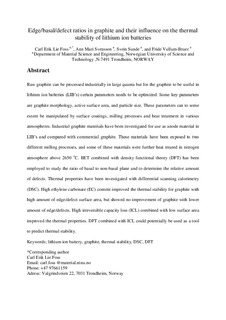| dc.contributor.author | Foss, Carl Erik Lie | |
| dc.contributor.author | Svensson, Ann Mari | |
| dc.contributor.author | Sunde, Svein | |
| dc.contributor.author | Vullum-Bruer, Fride | |
| dc.date.accessioned | 2017-11-07T11:54:09Z | |
| dc.date.available | 2017-11-07T11:54:09Z | |
| dc.date.created | 2016-05-20T12:43:06Z | |
| dc.date.issued | 2016 | |
| dc.identifier.citation | Journal of Power Sources. 2016, 317 177-183. | nb_NO |
| dc.identifier.issn | 0378-7753 | |
| dc.identifier.uri | http://hdl.handle.net/11250/2464608 | |
| dc.description.abstract | Raw graphite can be processed industrially in large quanta but for the graphite to be useful in lithium ion batteries (LIB's) certain parameters needs to be optimized. Some key parameters are graphite morphology, active surface area, and particle size. These parameters can to some extent be manipulated by surface coatings, milling processes and heat treatment in various atmospheres. Industrial graphite materials have been investigated for use as anode material in LIB's and compared with commercial graphite. These materials have been exposed to two different milling processes, and some of these materials were further heat treated in nitrogen atmosphere above 2650 °C. Brunauer-Emmett-Teller (BET) theory combined with density functional theory (DFT) has been employed to study the ratio of basal to non-basal plane and to determine the relative amount of defects. Thermal properties have been investigated with differential scanning calorimetry (DSC). High ethylene carbonate (EC) content improved the thermal stability for graphite with high amount of edge/defect surface area, but showed no improvement of graphite with lower amount of edge/defects. High irreversible capacity loss (ICL) combined with low surface area improved the thermal properties. DFT combined with ICL could potentially be used as a tool to predict thermal stability. | nb_NO |
| dc.language.iso | eng | nb_NO |
| dc.publisher | Elsevier | nb_NO |
| dc.title | Edge/basal/defect ratios in graphite and their influence on the thermal stability of lithium ion batteries | nb_NO |
| dc.type | Journal article | nb_NO |
| dc.description.version | submittedVersion | nb_NO |
| dc.source.pagenumber | 177-183 | nb_NO |
| dc.source.volume | 317 | nb_NO |
| dc.source.journal | Journal of Power Sources | nb_NO |
| dc.identifier.doi | 10.1016/j.jpowsour.2016.03.079 | |
| dc.identifier.cristin | 1356529 | |
| dc.description.localcode | This is a submitted manuscript of an article published by Elsevier Ltd in Journal of Power Sources, 22 April 2016. | nb_NO |
| cristin.unitcode | 194,66,35,0 | |
| cristin.unitname | Institutt for materialteknologi | |
| cristin.ispublished | true | |
| cristin.fulltext | preprint | |
| cristin.qualitycode | 1 | |
